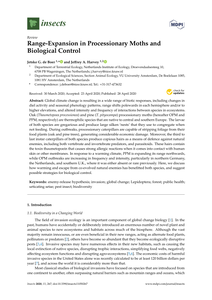Report in English on the results of the international Stadslab Master Class on urban segregation. The project focuses on the redevelopment strategy for the Lyuko valley in the Hungarian city of Miskolc. The valley is occupied by an increasing number of roma residents, who live in ramshackle buildings and very poor conditions. The international team develop design strategies for a long term re-integration strategy for the roma population. The report contains essays by international experts on segregation, integration policies, gypsy architecture and urban anthropology. The design strategy itself is extensively illustrated.
LINK
Global climate change is resulting in a wide range of biotic responses, including changes in diel activity and seasonal phenology patterns, range shifts polewards in each hemisphere and/or to higher elevations, and altered intensity and frequency of interactions between species in ecosystems.Oak (Thaumetopoea processionea) and pine (T. pityocampa) processionary moths (hereafter OPM and PPM, respectively) are thermophilic species that are native to central and southern Europe. The larvae of both species are gregarious and produce large silken ‘nests’ that they use to congregate when not feeding. During outbreaks, processionary caterpillars are capable of stripping foliage from theirfood plants (oak and pine trees), generating considerable economic damage. Moreover, the third to last instar caterpillars of both species produce copious hairs as a means of defence against naturalenemies, including both vertebrate and invertebrate predators, and parasitoids. These hairs contain the toxin thaumetopoein that causes strong allergic reactions when it comes into contact with humanskin or other membranes. In response to a warming climate, PPM is expanding its range northwards, while OPM outbreaks are increasing in frequency and intensity, particularly in northern Germany,the Netherlands, and southern U.K., where it was either absent or rare previously. Here, we discuss how warming and escape from co-evolved natural enemies has benefitted both species, and suggest possible strategies for biological control.
DOCUMENT

Snelle technologische ontwikkelingen bieden kansen voor de maritieme sector. Zij maken de scheepvaart efficiënter, veiliger en schoner. De techniek heeft regelgeving en professionals nodig die ook klaar zijn voor de toekomst. Het lectoraat Maritime Law voert praktijkgericht onderzoek uit op de scheidslijn van recht en (maritieme) techniek samen met studenten, docenten, het bedrijfsleven en kennisinstellingen.
MULTIFILE

Many, many comparisons have been drawn in recent years between the current rise of (right-wing) populism and the financial crisis of 2008 that shook and continues to shake Europe to its core, and the tumultuous and horrifying events of the 1930s, which in the end resulted in the Second World War. A number of recent studies which (partially) focus on this decade carry ominous titles like To Hell and Back, The Age of Catastrophe and The Triumph of the Dark. Referred to by some historians as the second Thirty Years’ War, the period from the First World War to the end of the Second still continues to draw much academic and indeed public attention. In many cases, Germany deservedly plays a central role in the analysis, either in the form of the Kaiserreich or the ill-fated Weimar Republic and, of course, Nazi Germany. The five books under review here discuss European history between 1914 and 1950 in general, and that of Germany in particular, in this period. What do these books tell us about Europe’s and Germany’s path in the first half of the twentieth century, and what new insights do they provide? https://doi.org/10.1177/0265691418777981 LinkedIn: https://www.linkedin.com/in/martijn-lak-71793013/
MULTIFILE
